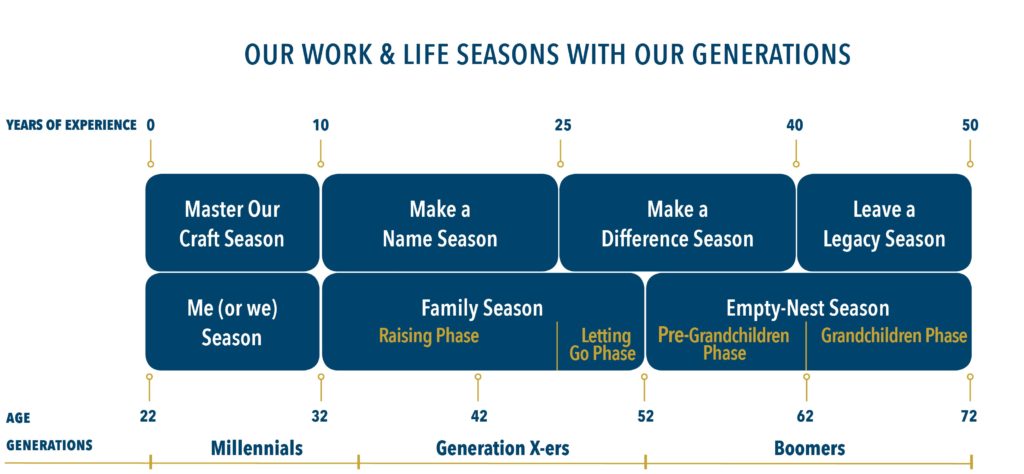Part 4: Doing Our Job as Employees
The New Rules for Employee Engagement
Part 4: Doing Our Job as Employees
We know leaders, managers, and organizations need to work harder and do things differently to create conditions for more effective employee engagement – especially today, but it’s not only about them. As employees, we play an equally vital role.
To be truly engaged, succeed, and live fully at the office and beyond, we need to:
- Know what we want
- Bring our best
- Control what we can
- Seek alignment
- Position ourselves for growth
Knowing What We Want
A high degree of self-awareness and emotional intelligence is not only needed to be an effective leader and manager, it is also needed to be an effective and engaged employee.
To win at both work and life as a professional we need a plan – and we need to design that plan to evolve as we grow and transition into new work and life seasons.
The graphic below is from my book, “Reversing Burnout. How to Immediately Engage Top Talent and Grow! A Blueprint for Professionals and Business Owners”.
This graphic illustrates our “typical” work and life seasons and generational alignment.
In general, we transition into new seasons as we progress through our life and career. At times, our seasons can either compliment or conflict. Our interests and passions also change from season to season.
There are certainly generational differences in the workplace today but there is also convergence, particularly around meaning, purpose, performance, and impact as a result of seasonal and societal shifts.
To stay engaged, it’s important to map our seasons, understand our changes, and continually align our actions with our goals and those of our team and organization.
Bringing Our Best
Employee engagement is a mutual commitment. Just as “a horse has to want to drink the water it’s led to”, an employee has to want to be engaged. Employees must also take action.
The “10 Things That Require Zero Talent” list that runs through social media is a good proxy for that action: being on time, work ethic, effort, body language, energy, attitude, passion, being coachable, doing extra, and being prepared.
If we fall short, this is an opportunity to work with our supervisor to develop the skills, systems, and mindset needed to consistently bring our best. It can also be an opportunity to discuss resetting expectations to best accommodate a new season or a particular situation.
Evaluating how we measure up can also be a wake-up call. If we have lost ground on the “10 Things”, that could be a sign we have drifted or are feeling the effects of prolonged workload, overwhelm, or burnout. This can be true for high-achieving professionals at all levels. When this is the case, we need to find a way to get back on the most appropriate track.
Controlling What We Can
If you are good at what you do and are dedicated – you will always be in demand. If you are a high-achiever – there will always be something to do.
“If you are good at what you do and are dedicated – you will always be in demand. If you are a high-achiever – there will always be something to do. We need to take control in order to achieve our goals.”
– Peter C. Atherton
To stay engaged and succeed without overwhelm and burnout, we need to control our time and energy.
When life seems out of control or misaligned, that is a cue to make more “margin” – quiet time and space to think, concentrate, contemplate, decompress, and plan. We need to design this time to make sure we are on-task with a better and more efficient “to-do” list with the right priorities, strategies, and sufficient boundaries to make them happen.
Seeking Alignment
Being in alignment is essential for employee engagement.
To be fully engaged, perform at our best, and sustain growth over the long-term, we must align with basic human needs and biology. Although this will adjust week-to-week, month-to-month, and season-to-season, we should generally align our 24-hour days and 168-hour weeks to be one-third work, one-third life, and one-third “margin” and restoration, including sleep.
Organizations have clients to serve and each of us has a role in serving them. To be effectively engaged, we must know that role. We must also understand how our organizations generate profit so we can best align with and enhance those processes and systems that lead to successful outcomes.
In addition to our day-to-day work tasks and responsibilities, we must also be aligned with the organization’s mission, vision, and values.
Beyond an organization’s “why”, there is a who, what, when, where, and how that drives employee engagement. As employees, we need to understand what specific areas of our work are engaging and which may not be… and why. Doing so allows us to discuss any needs or concerns with our supervisor.
Positioning for Growth
To stay engaged we must grow – both personally and professionally. We owe it to ourselves and to our organizations to grow.
As employees, are we taking advantage of all that’s being offered? If not, we need to. Do we have ideas on what other opportunities or training could be beneficial? If so, we need to share them.
If after doing all the above we cannot find engagement, there just might not be a right “fit” at this time. In that case, a pivot away may be beneficial for all parties; however, that should be a last resort.
The fact is, most successful leaders and organizations strive to do excellent work with others committed to the same. They also seek to provide opportunities for growth and advancement in friendly, supportive, engaging, and even fun atmospheres.
As employees at all levels, we need to know our roles and do our jobs to engage and connect with each other so we can continue to do great things through our work and beyond.
Links to the previous parts of this series are provided here:
The New Rules for Employee Engagement – Part 1: Know Your Role
The New Rules for Employee Engagement – Part 2: Doing Our Job as Leaders
The New Rules for Employee Engagement – Part 3: Doing Our Job as Managers
To your winning,

PS – Ready to increase your engagement and your impact? Check out our Fast Start Programs.
PSS – Click HERE… and then just sit back and listen to one of the most important chapters in “Reversing Burnout” for FREE. Learn more about the realities of work and life today and how you can reverse and avoid the “Burnout-Disengagement Cycle”.

Pete Atherton
About the Author
Peter C. Atherton, P.E. is an AEC industry insider with over 30 years of experience, having spent more than 24 as a successful professional civil engineer, principal, major owner, and member of the board of directors for high-achieving firms. Pete is now the President and Founder of ActionsProve, LLC, author of “Reversing Burnout. How to Immediately Engage Top Talent and Grow! A Blueprint for Professionals and Business Owners”, and the creator of the I.M.P.A.C.T. process.
Pete is also the host of The AEC Leadership Today Podcast and leads The AEC Leadership Mastermind.
Pete works with AEC firms to grow and advance their success through modern and new era focused strategic planning, executive coaching, leadership and management team development, performance-based employee engagement, and corporate impact design. Connect with him through the contact link below.



